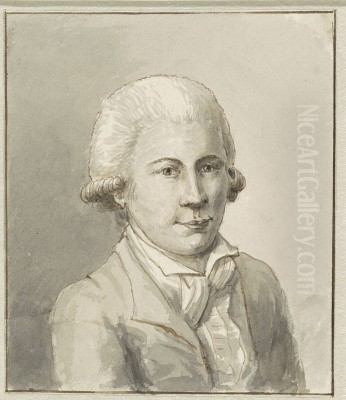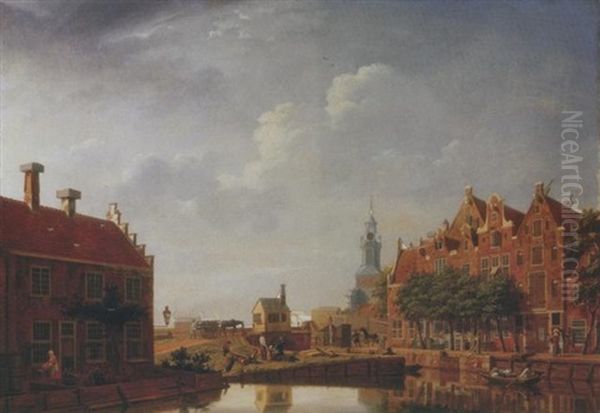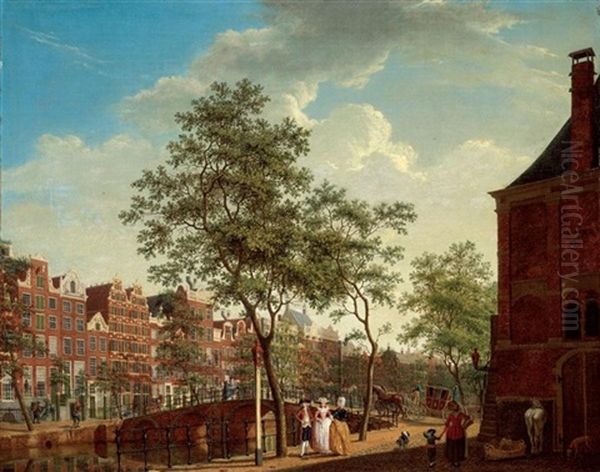
Isaac Ouwater stands as a significant, if sometimes overlooked, figure in the rich tapestry of Dutch art. Active in the latter half of the 18th century, he dedicated his artistic endeavors to the meticulous depiction of urban landscapes, primarily focusing on his native Amsterdam and other Dutch towns. His work provides an invaluable visual record of a Netherlands transitioning from its Golden Age, yet still vibrant with commercial and cultural life. Ouwater's paintings are characterized by their topographical accuracy, attention to architectural detail, and lively, populated scenes, offering a window into the daily existence of his contemporaries.
Early Life and Artistic Formation in Amsterdam
Isaac Ouwater was born in Amsterdam and baptized in the Amstelkerk on July 31, 1748. He passed away in his native city and was buried on March 4, 1793. His father, Isaac Ouwater Senior, was also a painter, specializing in landscapes and still lifes. This familial artistic environment likely provided the young Ouwater with his initial exposure to the world of art and the rudiments of painting. While specific details about his formal artistic training remain scarce, it is highly probable that his father played a crucial role in his early development as an artist.
Growing up in Amsterdam, a city renowned for its picturesque canals, distinctive gabled houses, and bustling public squares, Ouwater was immersed in a visual environment that would become the primary subject of his art. The city, though past the zenith of its 17th-century global dominance, remained a major European center for trade, finance, and culture. This provided an endless source of inspiration for an artist inclined towards capturing the intricacies of urban life and architecture. Ouwater spent most of his working life in Amsterdam, and his deep familiarity with its streets, buildings, and atmosphere is evident in the precision and affection with which he rendered them.
The Artistic Milieu: Dutch Cityscape Painting in the 18th Century

By the 18th century, the tradition of Dutch cityscape painting, or "stadsgezicht," was well-established. The 17th century, often referred to as the Dutch Golden Age, had seen masters like Jan van der Heyden (1637-1712) and the brothers Gerrit Berckheyde (1638-1698) and Job Berckheyde (1630-1693) elevate the genre to remarkable heights. These artists were celebrated for their incredibly detailed and realistic views of Dutch cities, often imbued with a serene, light-filled atmosphere. Their work set a high standard for topographical accuracy and compositional harmony.
Another important predecessor in architectural painting was Pieter Saenredam (1597-1665), known for his luminous and precise depictions of church interiors and exteriors, emphasizing perspective and architectural form. While Johannes Vermeer (1632-1675) is famed for his interior genre scenes, his "View of Delft" remains one of the most iconic cityscapes in art history, showcasing a remarkable sensitivity to light and atmosphere.
Isaac Ouwater emerged in a period when this tradition continued, albeit with some stylistic shifts. The Rococo influence, though more subdued in the Netherlands compared to France, could be seen in a preference for lighter palettes and more animated figural staffage in some works. Ouwater's paintings, while firmly rooted in the Dutch tradition of realism, sometimes exhibit a Rococo sensibility in the lively depiction of figures and the overall charm of his scenes. He was a contemporary of other cityscape painters such as Paulus Constantijn la Fargue (1729-1782), Jan ten Compe (1713-1761), Johannes Janson (1729-1784), and Hendrik Keun (1738-1787), who also contributed to the visual record of Dutch cities during this era.
Ouwater's Artistic Style and Meticulous Technique
Isaac Ouwater is best known as a painter of "town views," a genre that demanded both artistic skill and a keen observational eye. His style is characterized by a high degree of topographical precision. He meticulously rendered architectural details, ensuring that buildings and street layouts were accurately represented. This dedication to accuracy makes his paintings valuable historical documents, offering insights into the appearance of Dutch cities in the late 18th century.
His compositions are typically well-balanced, often employing a clear perspectival structure to lead the viewer's eye into the scene. Ouwater had a fine understanding of light and shadow, using it to model forms, create depth, and enliven his urban vistas. The play of sunlight on brick facades, the shadows cast by buildings, and the reflections in canals are all rendered with considerable skill. His palette is generally clear and naturalistic, capturing the specific atmospheric conditions of the Netherlands.

A distinctive feature of Ouwater's work is the inclusion of numerous small figures, or staffage. These figures are not mere accessories but are integral to his scenes, depicting the everyday activities of city dwellers – merchants conducting business, shoppers browsing, children playing, and citizens strolling. This lively human element infuses his paintings with a sense of dynamism and provides a narrative quality, transforming his architectural portraits into vibrant snapshots of urban life. While influenced by the precision of 17th-century masters like Jan van der Heyden and Gerrit Berckheyde, Ouwater's figures often have a slightly more animated, almost Rococo, charm.
Key Themes and Celebrated Subjects
Amsterdam was undoubtedly Ouwater's principal muse. He painted numerous views of its famous squares, canals, churches, and public buildings. The Dam Square, with the Royal Palace (formerly the Town Hall) and the Nieuwe Kerk, was a recurring subject. He also depicted various canals like the Herengracht and Keizersgracht, capturing the unique character of Amsterdam's waterways lined with elegant townhouses.
One of his most famous and historically significant works is "De boekhandel en het loterijkantoor van Jan de Groot in de Kalverstraat te Amsterdam" (The Bookstore and Lottery Office of Jan de Groot in Kalverstraat, Amsterdam), painted in 1779. This painting is a fascinating depiction of a bustling street scene. It shows a crowd of people pushing and shoving to enter Jan de Groot's establishment, which was both a bookshop and a lottery office. The painting vividly captures the excitement and energy surrounding lotteries, which were popular at the time. The work is notable for its detailed rendering of the architecture, the expressive gestures of the figures, and its value as a social document. This particular painting was even used as a cover image for a book, highlighting its engaging and illustrative quality.
Another important work is "The Nieuwe Kerk and Town Hall on Dam Square, Amsterdam" (circa 1780). Here, Ouwater masterfully captures the grandeur of these iconic structures, paying close attention to their architectural features. The interplay of light and shadow across the facades and the square itself, populated with figures going about their day, demonstrates his skill in creating both an accurate and an atmospheric representation.
Ouwater also painted views of other Dutch cities, including Haarlem. His painting of the "Groote Markt in Haarlem" showcases the city's central square with the Grote Kerk (St. Bavokerk) as its focal point. Like his Amsterdam scenes, this work is characterized by careful attention to architectural detail and lively staffage, providing a valuable visual record of Haarlem in the 18th century. "Le moulin, Amsterdam" (The Mill, Amsterdam) is another example of his work, depicting a quintessential Dutch scene with his characteristic precision and charm.
Influences and Connections: Ouwater in the Dutch Artistic Landscape

Isaac Ouwater's art did not develop in a vacuum. He was clearly indebted to the great tradition of 17th-century Dutch cityscape painters. The meticulous detail and clarity of Jan van der Heyden and the balanced compositions and light effects of Gerrit Berckheyde served as foundational models for any artist working in this genre. Ouwater absorbed these influences, adapting them to his own time and sensibility. The influence of Jan de Goot has also been noted by some sources, likely another contemporary or slightly earlier painter working in a similar vein.
While the primary Haarlem School is associated with the 17th century, featuring artists like Frans Hals (portraiture) and Jacob van Ruisdael (landscapes, and some Haarlem views), the tradition of depicting Haarlem continued. Ouwater's views of Haarlem place him within this ongoing tradition of artists chronicling the city. It's more accurate to see him as a contributor to this legacy rather than a founder of any new "school" in the 18th century.
Ouwater's work, in turn, had an impact on later artists. Cornelis Springer (1817-1891), one of the most important Dutch cityscape painters of the 19th century, is known to have been inspired by Ouwater. Springer, celebrated for his romanticized and highly detailed views of Dutch towns, looked back to artists like Ouwater who had mastered the art of topographical accuracy combined with picturesque charm.
The provided information also mentions potential, though less direct, connections or stylistic parallels with much earlier Netherlandish masters like Petrus Christus (c. 1410/1420 – 1475/1476) and Jan van Eyck (c. 1390 – 1441). While these Early Netherlandish painters worked in a very different era and style, their pioneering attention to detail, realism, and the depiction of urban settings (often as backgrounds in religious scenes) laid a distant groundwork for the later specialization in cityscape painting. Similarly, Joost Cornelisz Droochsloot (1586–1666), a 17th-century painter of village scenes and genre works, also contributed to the broader tradition of depicting Dutch life and environments.
Regarding direct collaborations or intense rivalries with contemporaries like Jan van de Goot or Gerrit Berckheyde (who was of an earlier generation), the available evidence is limited. Artists of the period certainly knew of each other's work, and their paintings were often collected and exhibited together, suggesting a shared artistic environment and mutual recognition rather than overt, documented competition or specific joint projects in Ouwater's case. His relationship with these figures seems to be more one of artistic lineage and shared genre focus.
Personal Life: A Glimpse Beyond the Canvas
Details about Isaac Ouwater's personal life are relatively sparse, as is common for many artists of his era unless they achieved superstar status or were subjects of extensive contemporary documentation. We know he married Anna Louisa Charlotte Dorense in 1772. His father, Isaac Senior, being a painter, suggests an upbringing where art was a familiar presence and perhaps a natural career path. He lived and worked primarily in Amsterdam, the city that so thoroughly dominates his oeuvre. Beyond these facts, much of his personal life remains private, with his legacy primarily residing in the canvases he left behind.
Exhibitions, Collections, and Publications: Preserving Ouwater's Legacy
Isaac Ouwater's paintings are held in various prestigious collections, ensuring their preservation and accessibility for study and appreciation. The Rijksmuseum in Amsterdam, the premier museum for Dutch art, holds significant works, including the aforementioned "De boekhandel en het loterijkantoor van Jan de Groot." The Haags Historisch Museum (Historical Museum of The Hague) also includes his works in its collection. His paintings can also be found in other museums in the Netherlands and abroad, as well as in private collections. For instance, some of his works are noted as being in the museum in Dunkirk, France.
His paintings have been featured in various exhibitions over the years. For example, "De boekhandel..." was part of an exhibition at the Rijksmuseum. His view of the "Groote Markt" in Haarlem has also been exhibited. Such exhibitions play a crucial role in bringing an artist's work to a wider audience and fostering art historical research.
Ouwater's work has also been discussed and reproduced in a number of art historical publications and books that touch upon Dutch art, cityscape painting, or the cultural history of the period. These include:
"Painting and Publishing as Cultural Industries: The Fabric of Creativity in the Dutch Republic, 1580-1800," which mentions "De boekhandel..."
"From Pedlars to Textile Barons: The Economic Development of a Jewish Minority Group in the Netherlands," which references a painting by him from 1783.
"Oil Sketches and Paintings 1750-1920," a publication that cites his work.
"The Healthy City: The Art of Survival throughout the Ages," where his depictions of urban landscapes are relevant.
An article titled "The remarkable case of Johannes Torrentius – Rembrandt's Room" mentions one of his paintings from 1780.
These references in scholarly and general interest publications underscore the enduring value of Ouwater's work, both as art and as historical documentation.
Social Impact and Art Historical Evaluation
Isaac Ouwater's primary social impact lies in the visual record he created of 18th-century Dutch urban environments. His paintings offer a vivid and detailed glimpse into the architecture, daily life, and atmosphere of cities like Amsterdam and Haarlem during his lifetime. For historians, urban planners, and those interested in the evolution of cityscapes, his works are invaluable resources. They document not only specific buildings and locations but also aspects of social life, commerce, and leisure.
In the broader context of art history, Ouwater is recognized as a skilled practitioner of cityscape painting in the 18th-century Dutch tradition. He successfully carried forward the legacy of 17th-century masters while imbuing his work with a sensibility characteristic of his own era. While he may not be considered a revolutionary innovator on the scale of a Rembrandt or Vermeer, his contribution to his chosen genre is significant. He excelled in topographical accuracy, detailed rendering, and the creation of lively, engaging urban scenes.
His influence on subsequent painters, notably Cornelis Springer, further solidifies his place in the lineage of Dutch cityscape artists. While his fame might be more localized within the Netherlands and among specialists in Dutch art, his paintings continue to be admired for their technical proficiency, historical interest, and charming depiction of a bygone era. He was a dedicated craftsman who captured the spirit of his city with precision and affection.
Conclusion: An Enduring Vision of Urban Holland
Isaac Ouwater was more than just a painter of buildings and streets; he was a chronicler of urban life, a visual historian of his time. His canvases transport us to the bustling squares and serene canals of 18th-century Amsterdam and Haarlem, allowing us to witness the daily rhythms of a society that, while changed from its Golden Age peak, still possessed a unique charm and vitality. His meticulous attention to detail, his skillful handling of light and perspective, and his ability to populate his scenes with lively figures ensure his enduring appeal. Though perhaps not as widely known as some of his 17th-century predecessors, Isaac Ouwater holds a secure and respected place in the history of Dutch art, particularly for those who cherish the intricate and evocative genre of the cityscape. His work remains a testament to the enduring beauty of Dutch cities and the talent of an artist who dedicated his life to capturing their essence.